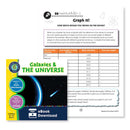Description
**THIS IS AN INSTANT DOWNLOAD**
This FREE worksheet includes 1 page from our Galaxies & the Universe title.
This Hands-On Activity asks students to calculate how much they would weigh on different objects in our solar system, including planets, the moon and the sun. This worksheet can be used on its own, or paired with the individual resource. And the best part is, it's FREE.
************************************************************************
About the full resource, Galaxies & the Universe:
From the smallest particles of matter to the biggest star system, our universe is made up of all things that exist in space. Our resource gives you the big picture about space. Start off by exploring the Big Bang and formation of our Milky Way galaxy. Learn how distance is measured in light years, and how far the next closest star is to Earth. Create your own nebula using construction pager, newspaper and water. Build pinhole galaxies to present barred, elliptical, spiral, and irregular galaxies to the class. Find out how much you would weigh on the sun, moon and planets. Solve the mystery of black holes and write your own science fiction story about it. Finally, travel to the most distant objects in our universe: quasars. Aligned to the Next Generation State Standards and written to Bloom's Taxonomy and STEAM initiatives, additional hands-on experiments, crossword, word search, comprehension quiz and answer key are also included.
This FREE worksheet includes 1 page from our Galaxies & the Universe title.
This Hands-On Activity asks students to calculate how much they would weigh on different objects in our solar system, including planets, the moon and the sun. This worksheet can be used on its own, or paired with the individual resource. And the best part is, it's FREE.
************************************************************************
About the full resource, Galaxies & the Universe:
From the smallest particles of matter to the biggest star system, our universe is made up of all things that exist in space. Our resource gives you the big picture about space. Start off by exploring the Big Bang and formation of our Milky Way galaxy. Learn how distance is measured in light years, and how far the next closest star is to Earth. Create your own nebula using construction pager, newspaper and water. Build pinhole galaxies to present barred, elliptical, spiral, and irregular galaxies to the class. Find out how much you would weigh on the sun, moon and planets. Solve the mystery of black holes and write your own science fiction story about it. Finally, travel to the most distant objects in our universe: quasars. Aligned to the Next Generation State Standards and written to Bloom's Taxonomy and STEAM initiatives, additional hands-on experiments, crossword, word search, comprehension quiz and answer key are also included.






